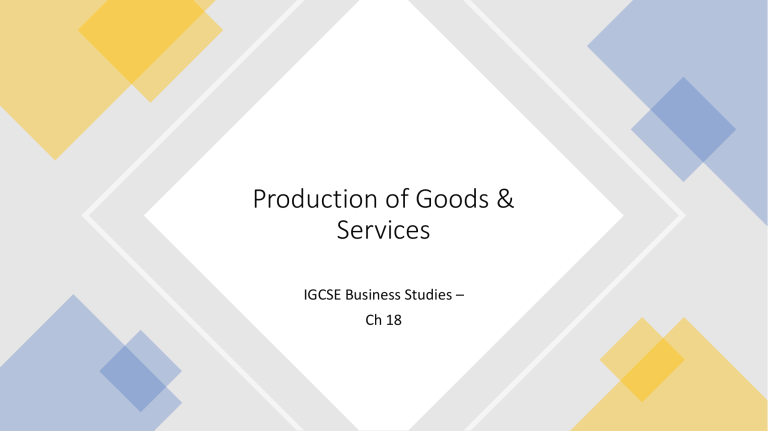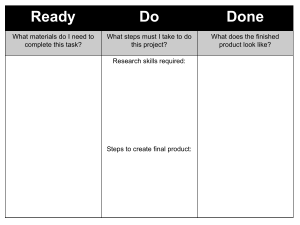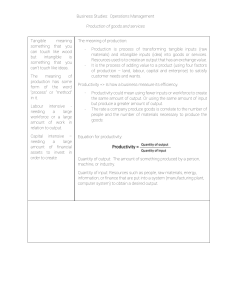
Production of Goods & Services IGCSE Business Studies – Ch 18 Production efficiency • It is important that a business makes effective use of its assets. The investment in production capacity is often significant. Think about how much it costs to set up a factory; the production line with all its machinery and technology. One way to look at how efficiently a business operates is to look at "productivity". • Productivity measures the relationship between inputs into the production process and the resultant outputs. Productivity can be measured in several ways: e.g. • Output per worker or hour of labour • Output per hour / day / week • Output per machine • Unit costs (total costs divided by total output) Why is achieving high productivity important? Most importantly, a more efficient business will produce lower cost goods than competitors. That means the business can either make a higher profit per unit sold (assuming that the product is sold for the same price as a competitor) or the business can offer customers a lower price than competitors (and still make a good profit/ Investing in production assets (e.g. equipment, factory buildings) is expensive – a business needs to maximise the return it makes on these assets Ways in which a business can try to improve its productivity Training – e.g. on-the-job training that allows an employee to improve skills required to work more productively Improved motivation – more motivated employees tend to produce greater output for the same effort than de-motivated ones More or better capital equipment (this links with the topic of automation) Better quality raw materials (reduces amount of time wasted on rejected products) Improved organisation of production – e.g. less wastage https://retail.economictimes.indiatimes.com/news/brand-solutions/how-to-streamline-your-inventory-management-processes/69859000 LEAN PRODCUTION LEAN PRODUCTION By avoiding such wastage, a firm can benefit in many ways…… less storage of raw materials, components and finished goods- less money and time tied up in inventory quicker production of goods and services no need to repair faulty goods- leads to good customer satisfaction ultimately, costs will lower, which helps reduce prices, making the business more competitive and earn higher profits as well WAYS TO IMPLEMENT LEAN PRODUCTION KAIZEN • Kaizen: it’s a Japanese term meaning ‘continuous improvement’. It aims to increase efficiency and reduce wastage by getting workers to get together in small groups and discuss problems and suggest solutions. Since they’re the ones directly involved in production they will know best to identify issues. When kaizen is implemented, the factory floor, for example, is rearranged by re-positioning machinery and equipment so that production can flow smoothly through the factory in the least possible time. Benefits: • increased productivity • reduced amount of space needed for production • improved factory layout may allow some jobs to be combined, so freeing up employees to do other jobs in the factory WAYS TO IMPLEMENT LEAN PRODUCTION - JIT • Just-in-Time inventory control: this techniques eliminates the need to hold any kind of inventory by ensuring that supplies arrive just in time they are needed for production. The making of any parts is done just in time to be used in the next stage of production and finished goods are made just in time they are needed for delivery to the customer/shop. The firm will need very reliable suppliers and an efficient system for reordering supplies. • Benefits: • Reduces cost of holding inventory • Warehouse space is not needed any more, so more space is available for other uses • Finished goods are immediately sold off, so cash flows in quickly WAYS TO IMPLEMENT LEAN PRODUCTION – CELL PRODUCTION • Cell Production: the production line is divided into separate, self-contained units each making a part of the finished good. This works because it improves worker morale when they are put into teams and concentrate on one part alone. Factors that affect which production method to use: The nature of the product: Whether it is a personal, customizedto-order product, in which case job production will be used. If it is a standard product, then flow production will be used The size of the market: For a large market, flow production will be required. Small local and niche markets may make use of batch and flow production. Goods that are highly demanded but not in very large quantities, batch production is most suitable. The nature of demand: If there is a fair and steady demand for the product, it would be more suitable to run a production line for the product. For less frequent demand, batch and job will be appropriate. The size of the business: Small firms with little capital access will not produce using large automated production lines, but will use batch and job production. Technology and Production Automation: equipment used in the factory is controlled by computers to carry out mechanical processes, such as spray painting a car body. Mechanization: production is done by machines but is operated by people CIM (computer integrated manufacturing): The computers that design the product using CAD is connected to the CAM software to directly produce the physical design. CAD (computer aided designing): a computer software that draws items being designed more quickly and allows them to be rotated, zoomed in and viewed from all angles. EPOS (electronic point-of-sale): used at checkouts/tills where operator scans the bar-code of each item bought by the customer individually. CAM (computer aided manufacturing): computers monitor the production process and controls machines and robots-similar to automation EFTPOS (electronic funds transfer at point-of-sale): the electronic cash register at the till will be connected to the retailer’s main computer and different banks.




